The Highly Sensitive Refractive Index Sensing of Seawater Based on a Large Lateral Offset Mach–Zehnder Interferometer
Abstract
:1. Introduction
2. Theoretical Analysis
3. Design of the Sensor
3.1. Optimization of the Sensor
3.2. Simulation of Sensor Transmission Spectrum
4. Experiment and Discussion
4.1. Fabrication of Fiber-Optic Sensor
4.2. Experimental Procedures
4.3. Results and Discussions
5. Conclusions
Author Contributions
Funding
Institutional Review Board Statement
Informed Consent Statement
Data Availability Statement
Conflicts of Interest
References
- Seiichi Serikawa, Y.; Takahashi, S.; Serikawa, S. Cognitive ocean of things: A comprehensive review and future trends. Wirel. Netw. 2022, 28, 917–926. [Google Scholar]
- Min, R.; Liu, Z.; Pereira, L.; Yang, C.; Sui, Q.; Marques, C. Optical fiber sensing for marine environment and marine structural health monitoring: A review. Opt. Laser Technol. 2021, 140, 107082. [Google Scholar] [CrossRef]
- Walls, L.G.; Reusch, T.; Clemmesen, C.; Ory, N.C. Effects of changing environmental conditions on plastic ingestion and feeding ecology of a benthopelagic fish (Gadus morhua) in the Southwest Baltic Sea. Mar. Pollut. Bull. 2022, 182, 114001. [Google Scholar] [CrossRef] [PubMed]
- Cai, W.; Wang, G.; Dewitte, B.; Wu, L.; Santoso, A.; Takahashi, K.; Yang, Y.; Carréric, A.; McPhaden, M.J. Increased variability of eastern Pacific El Niño under greenhouse warming. Nature 2018, 564, 201–206. [Google Scholar] [CrossRef] [PubMed]
- Gu, L.; He, X.; Zhang, M.; Lu, H. Advances in the Technologies for Marine Salinity Measurement. J. Mar. Sci. Eng. 2022, 10, 2024. [Google Scholar] [CrossRef]
- Jijesh, J.J.; Shivashankar; Susmitha, M.; Bhanu, M.; Sindhanakeri, P. Development of a CTD Sensor Subsystem for Oceanographic Application. In Proceedings of the 2017 2nd IEEE International Conference on Recent Trends in Electronics, Information & Communication Technology (RTEICT), Bangalore, India, 19–20 May 2017; pp. 1487–1492. [Google Scholar]
- De Robertis, A.; Handegard, N.O. Fish avoidance of research vessels and the efficacy of noise-reduced vessels: A review. ICES J. Mar. Sci. 2013, 70, 34–45. [Google Scholar] [CrossRef]
- Rudnick, D.L. Ocean Research Enabled by Underwater Gliders. Annu. Rev. Mar. Sci. 2016, 8, 519–541. [Google Scholar] [CrossRef] [PubMed]
- Wynn, R.B.; Huvenne, V.A.I.; Le Bas, T.P.; Murton, B.J.; Connelly, D.P.; Bett, B.J.; Ruhl, H.A.; Morris, K.J.; Peakall, J.; Parsons, D.R.; et al. Autonomous Underwater Vehicles (AUVs): Their past, present and future contributions to the advancement of marine geoscience. Mar. Geol. 2014, 352, 451–468. [Google Scholar] [CrossRef]
- Shadpour, H.; Hupert, M.L.; Patterson, D.; Liu, C.; Galloway, M.; Stryjewski, W.; Goettert, J.; Soper, S.A. Multichannel Microchip Electrophoresis Device Fabricated in Polycarbonate with an Integrated Contact Conductivity Sensor Array. Anal. Chem. 2007, 79, 870–878. [Google Scholar] [CrossRef]
- Fry, X.Q.; Fry, E.S. Empirical equation for the index of refraction of seawater. Appl. Opt. 1995, 34, 3477–3480. [Google Scholar]
- Li, G.; Wang, Y.; Shi, A.; Liu, Y.; Li, F. Review of Seawater Fiber Optic Salinity Sensors Based on the Refractive Index Detection Principle. Sensors 2023, 23, 2187. [Google Scholar] [CrossRef] [PubMed]
- Liang, H.; Wang, J.; Zhang, L.; Liu, J.; Wang, S. Review of Optical Fiber Sensors for Temperature, Salinity, and Pressure Sensing and Measurement in Seawater. Sensors 2022, 22, 5363. [Google Scholar] [CrossRef] [PubMed]
- Cai, J.; Liu, Y.; Shu, X. Long-Period Fiber Grating Sensors for Chemical and Biomedical Applications. Sensors 2023, 23, 542. [Google Scholar] [CrossRef] [PubMed]
- Dandapat, K.; Tripathi, S.M.; Chinifooroshan, Y.; Bock, W.J.; Mikulic, P. Compact and cost-effective temperature-insensitive bio-sensor based on long-period fiber gratings for accurate detection of E. coli bacteria in water. Opt. Lett. 2016, 41, 4198–4201. [Google Scholar] [CrossRef] [PubMed]
- Liu, C.; Cai, Q.; Xu, B.; Zhu, W.; Zhang, L.; Zhao, J.; Chen, X. Graphene oxide functionalized long period grating for ultrasensitive label-free immunosensing. Biosens. Bioelectron. 2017, 94, 200–206. [Google Scholar] [CrossRef]
- Del, V.I.; Cruz, J.L.; Socorro, A.B.; Corres, J.M.; Matias, I.R. Sensitivity optimization with cladding-etched long period fiber gratings at the dispersion turning point. Opt. Express 2016, 24, 17680–17685. [Google Scholar]
- Piestrzyńska, M.; Dominik, M.; Kosiel, K.; Janczuk-Richter, M.; Szot-Karpińska, K.; Brzozowska, E.; Shao, L.; Niedziółka-Jonsson, J.; Bock, W.J.; Śmietana, M. Ultrasensitive tantalum oxide nano-coated long-period gratings for detection of various biological targets. Biosens. Bioelectron. 2019, 133, 8–15. [Google Scholar] [CrossRef] [PubMed]
- Wang, X.; Wang, J.; Wang, S.; Liao, Y. Fiber-Optic Salinity Sensing With a Panda-Microfiber-Based Multimode Interferometer. J. Light. Technol. 2017, 35, 5086–5091. [Google Scholar] [CrossRef]
- Urrutia, A.; Del Villar, I.; Zubiate, P.; Zamarreño, C.R. A Comprehensive Review of Optical Fiber Refractometers: Toward a Standard Comparative Criterion. Laser Photonics Rev. 2019, 13, 1900094. [Google Scholar] [CrossRef]
- Yu, F.; Xue, P.; Zheng, J. Study of a large lateral core-offset in-line fiber modal interferometer for refractive index sensing. Opt. Fiber Technol. 2019, 47, 107–112. [Google Scholar] [CrossRef]
- Niu, P.; Jiang, J.; Wang, S.; Liu, K.; Ma, Z.; Zhang, Y.; Chen, W.; Liu, T. Optical fiber laser refractometer based on an open microcavity Mach-Zehnder interferometer with an ultra-low detection limit. Opt. Express 2020, 28, 30570–30585. [Google Scholar] [CrossRef]
- Zhao, Y.; Zhang, Y.; Hu, H.; Yang, Y.; Lei, M.; Wang, S. High-sensitive Mach-Zehnder interferometers based on no-core optical fiber with large lateral offset. Sens. Actuators A Phys. 2018, 281, 9–14. [Google Scholar] [CrossRef]
- Mu, X.; Yang, Y.; Wang, J.; Bi, L. High sensitive Mach-Zehnder interferometer for seawater refractive index measurement. Ferroelectrics 2022, 595, 27–34. [Google Scholar] [CrossRef]
- Dong, X.; Zeng, L.; Chu, D.; Sun, X.; Duan, J. Highly sensitive refractive index sensing based on a novel Mach-Zehnder interferometer with TCF-PCF composite structure. Infrared Phys. Technol. 2022, 123, 104134. [Google Scholar] [CrossRef]
- Xu, W.; Yang, X.; Zhang, C.; Shi, J.; Xu, D.; Zhong, K.; Yang, K.; Li, X.; Fu, W.; Liu, T.; et al. All-fiber seawater salinity sensor based on fiber laser intracavity loss modulation with low detection limit. Opt. Express 2019, 27, 1529. [Google Scholar] [CrossRef]
- Cheng, P.; Yang, M.; Hu, W.; Guo, D.; Du, C.; Luo, X.; Mumtaz, F. Refractive index interferometer based on SMF-MMF-TMCF-SMF structure with low temperature sensitivity. Opt. Fiber Technol. 2020, 57, 102233. [Google Scholar] [CrossRef]
- Lin, Z.; Lv, R.; Zhao, Y.; Zheng, H.; Wang, X. High-sensitivity special open-cavity Mach-Zehnder structure for salinity measurement based on etched double-side hole fiber. Opt. Lett. 2021, 46, 2714–2717. [Google Scholar] [CrossRef]
- Zheng, H.; Lv, R.; Zhao, Y.; Tong, R.; Lin, Z.; Wang, X.; Zhou, Y.; Zhao, Q. Multifunctional optical fiber sensor for simultaneous measurement of temperature and salinity. Opt. Lett. 2020, 45, 6631–6634. [Google Scholar] [CrossRef] [PubMed]
- Gao, S.; Zhang, W.; Bai, Z.; Zhang, H.; Geng, P.; Lin, W.; Li, J. Ultrasensitive Refractive Index Sensor Based on Microfiber-Assisted U-Shape Cavity. IEEE Photonics Technol. Lett. 2013, 25, 1815–1818. [Google Scholar] [CrossRef]
- Wang, B.; Wang, Q. An interferometric optical fiber biosensor with high sensitivity for IgG/anti-IgG immunosensing. Opt. Commun. 2018, 426, 388–394. [Google Scholar] [CrossRef]
- Pang, B.; Gu, Z.; Ling, Q.; Wu, W.; Zhou, Y. Simultaneous measurement of temperature and surrounding refractive index by superimposed coated long period fiber grating and fiber Bragg grating sensor based on mode barrier region. Optik 2020, 220, 165136. [Google Scholar] [CrossRef]
- Zeng, L.; Dong, X.; Sun, X.; Duan, J.A. Highly sensitive refractive index sensing based on PCF modal interferometer. Optik 2022, 251, 168360. [Google Scholar] [CrossRef]
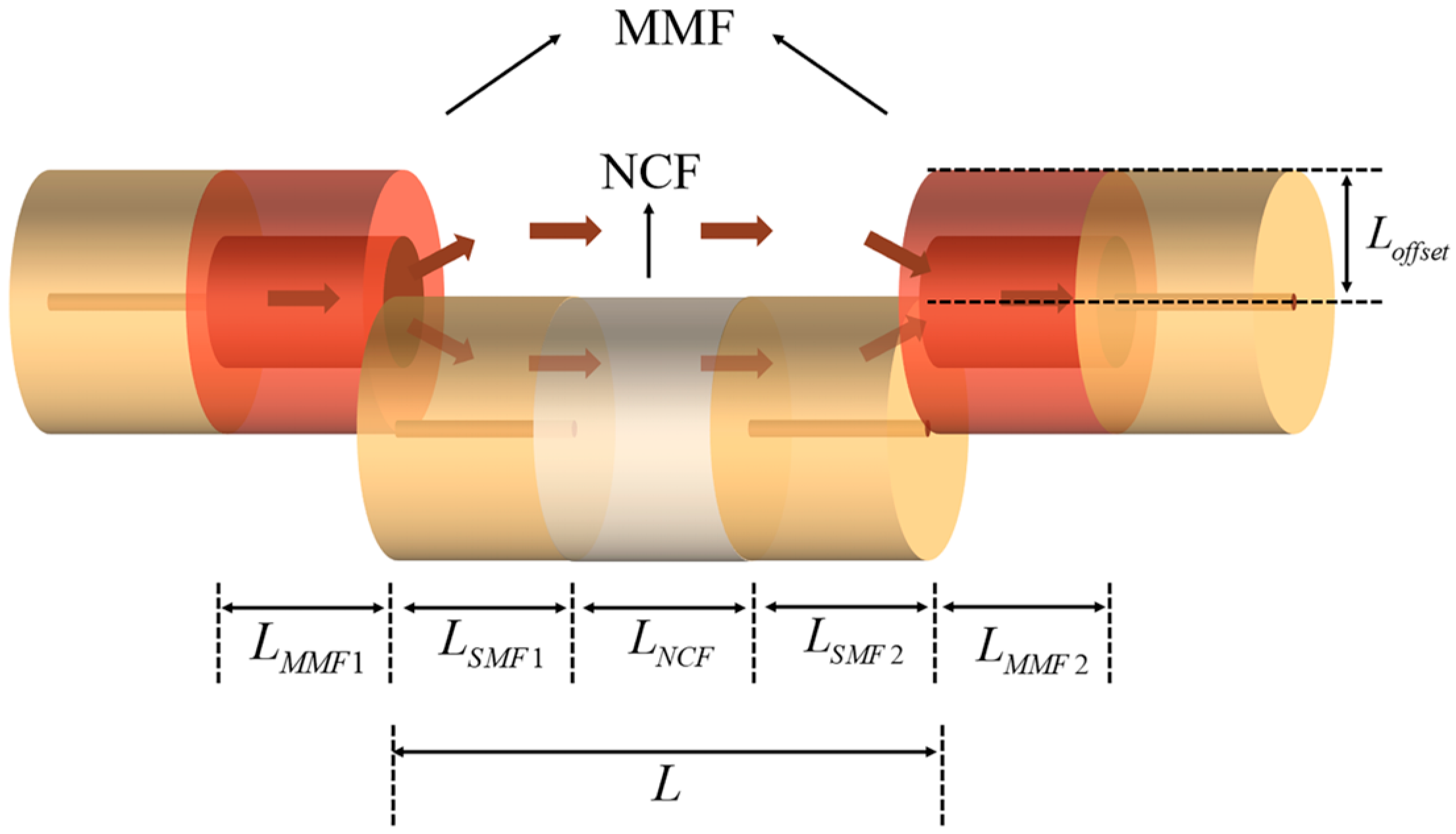


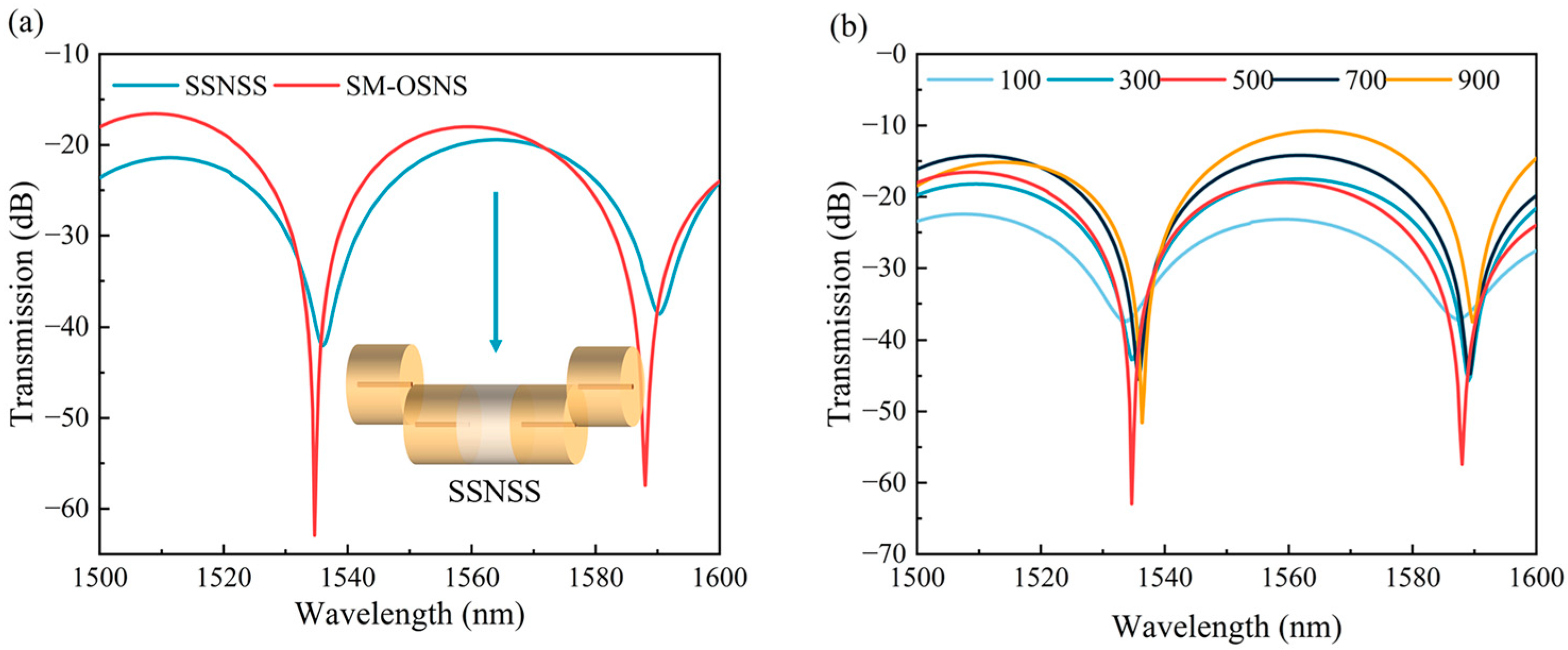
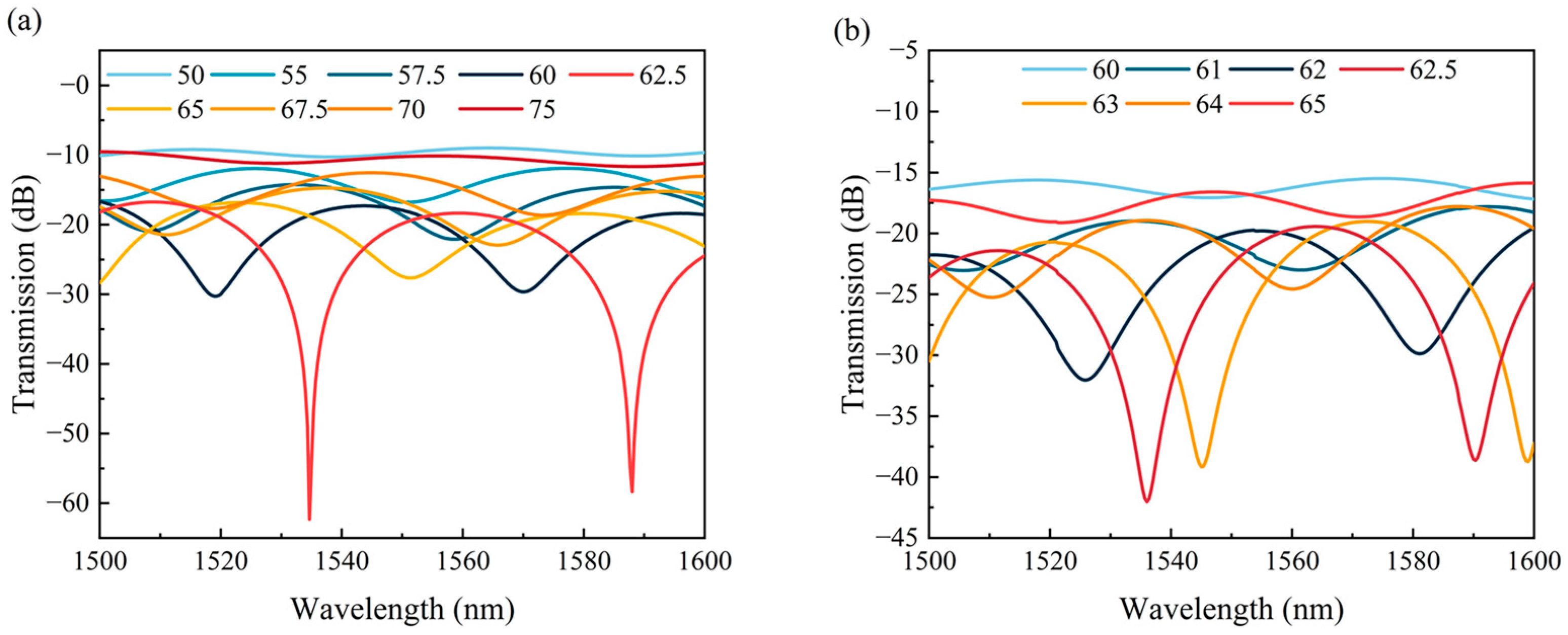
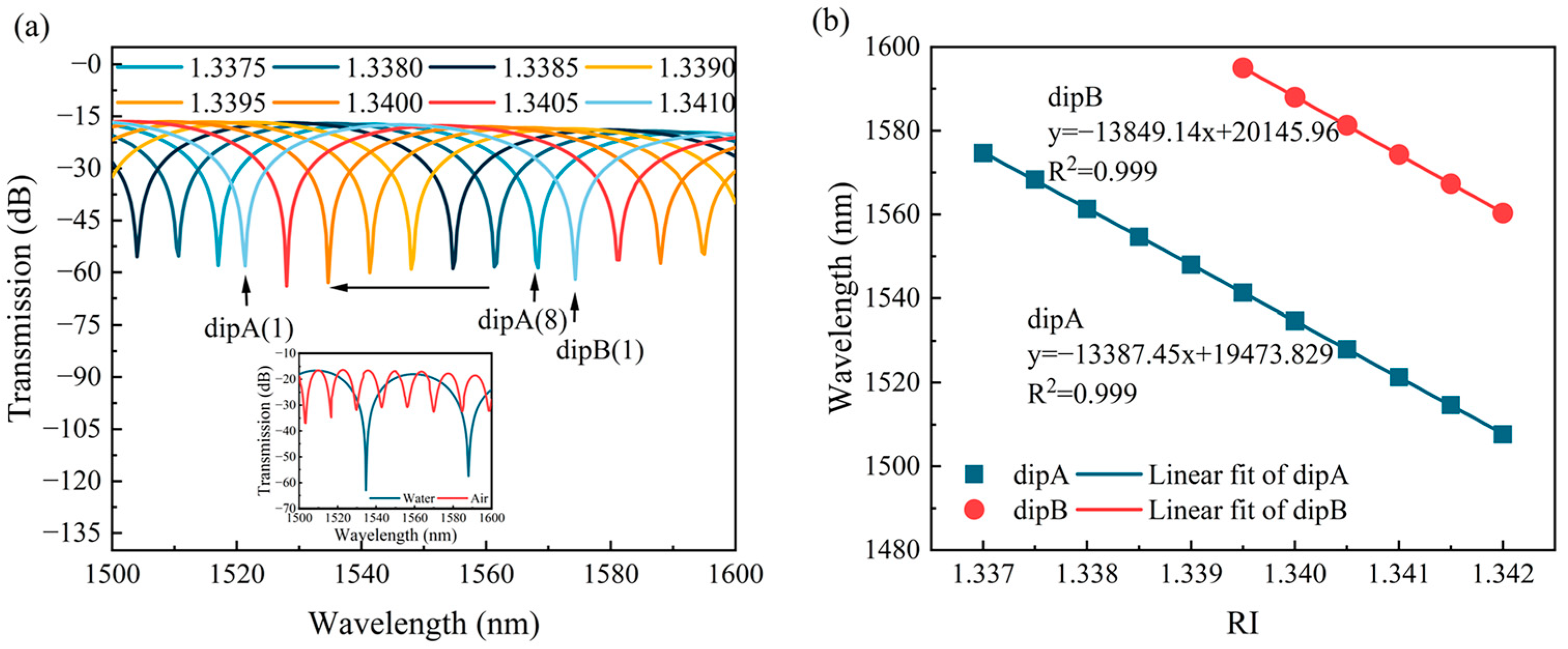
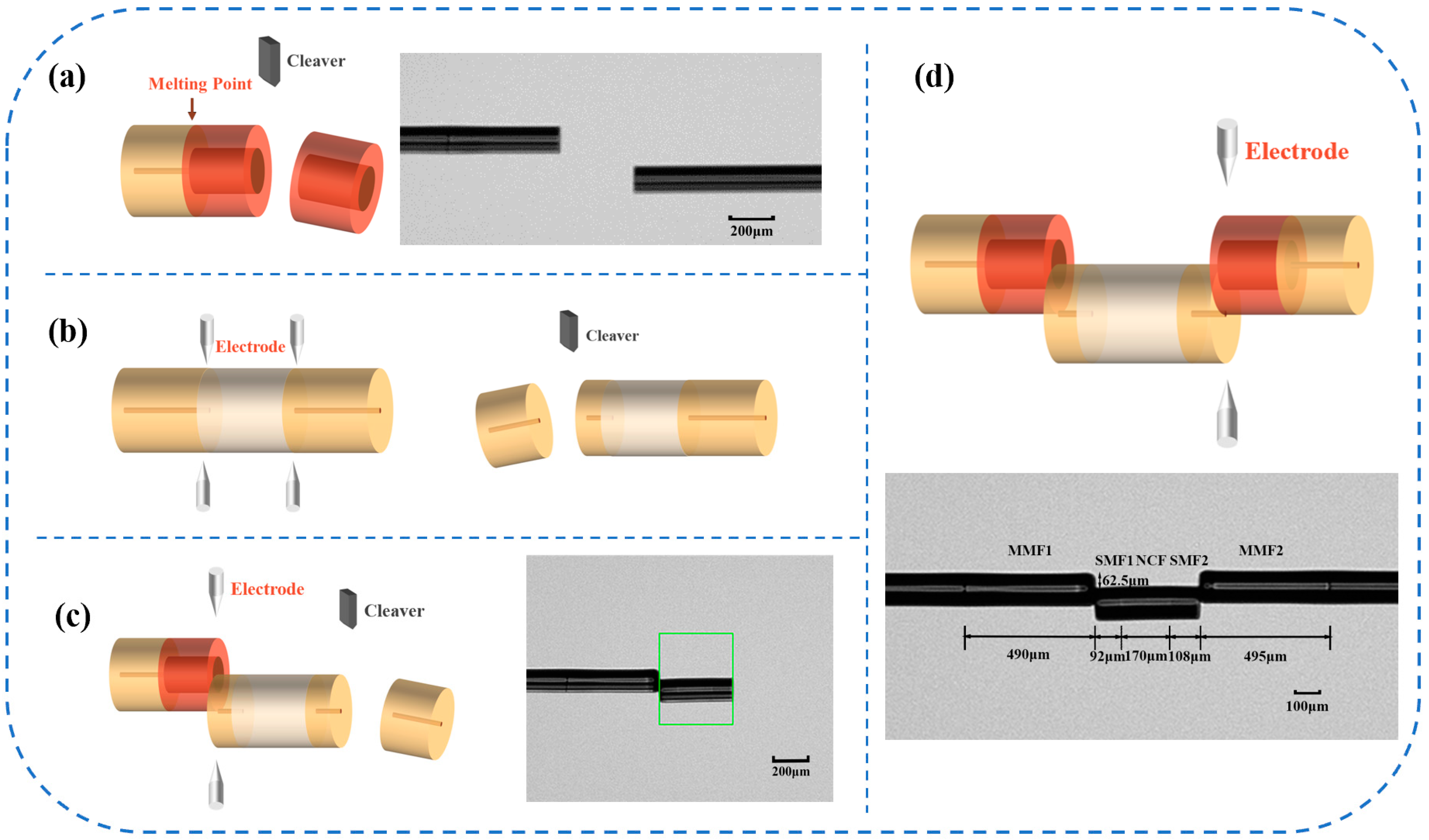

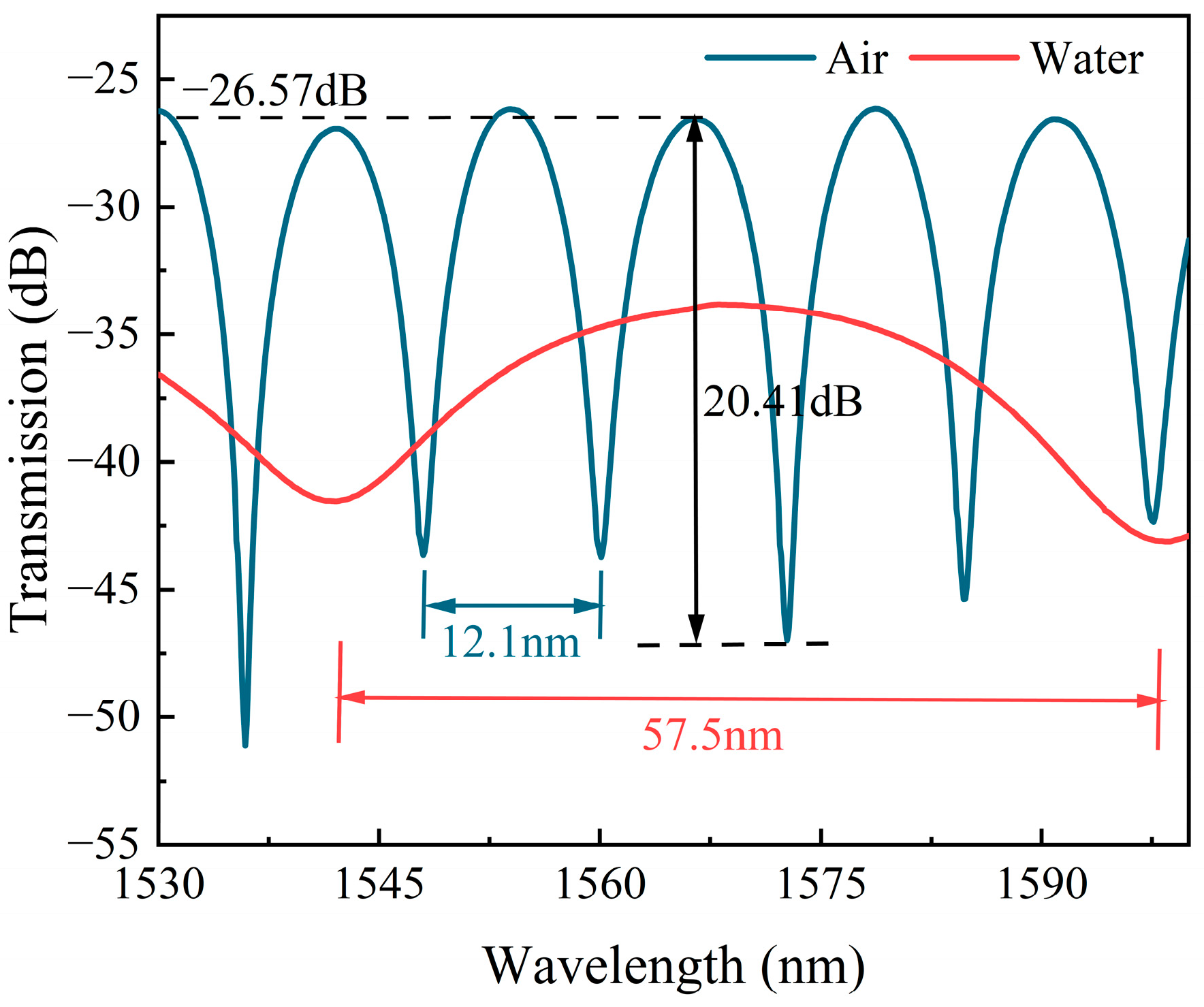
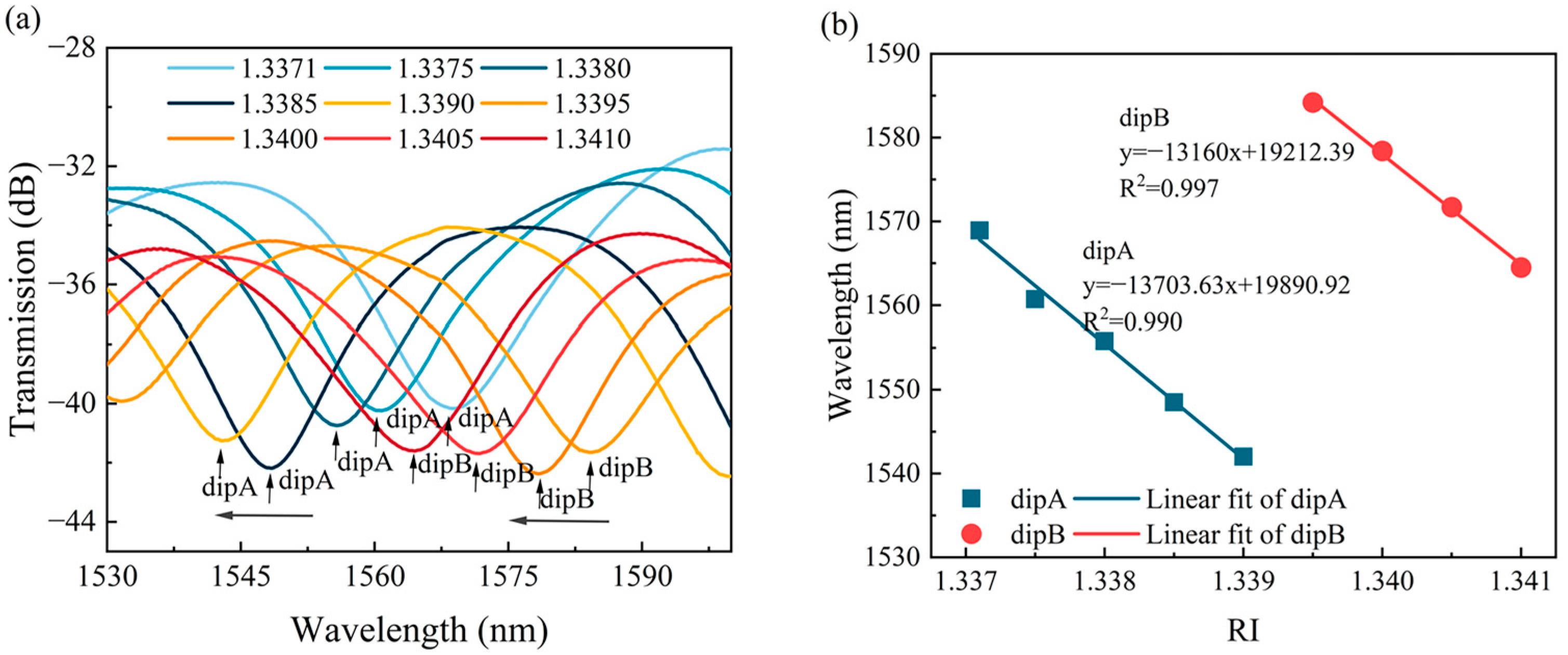
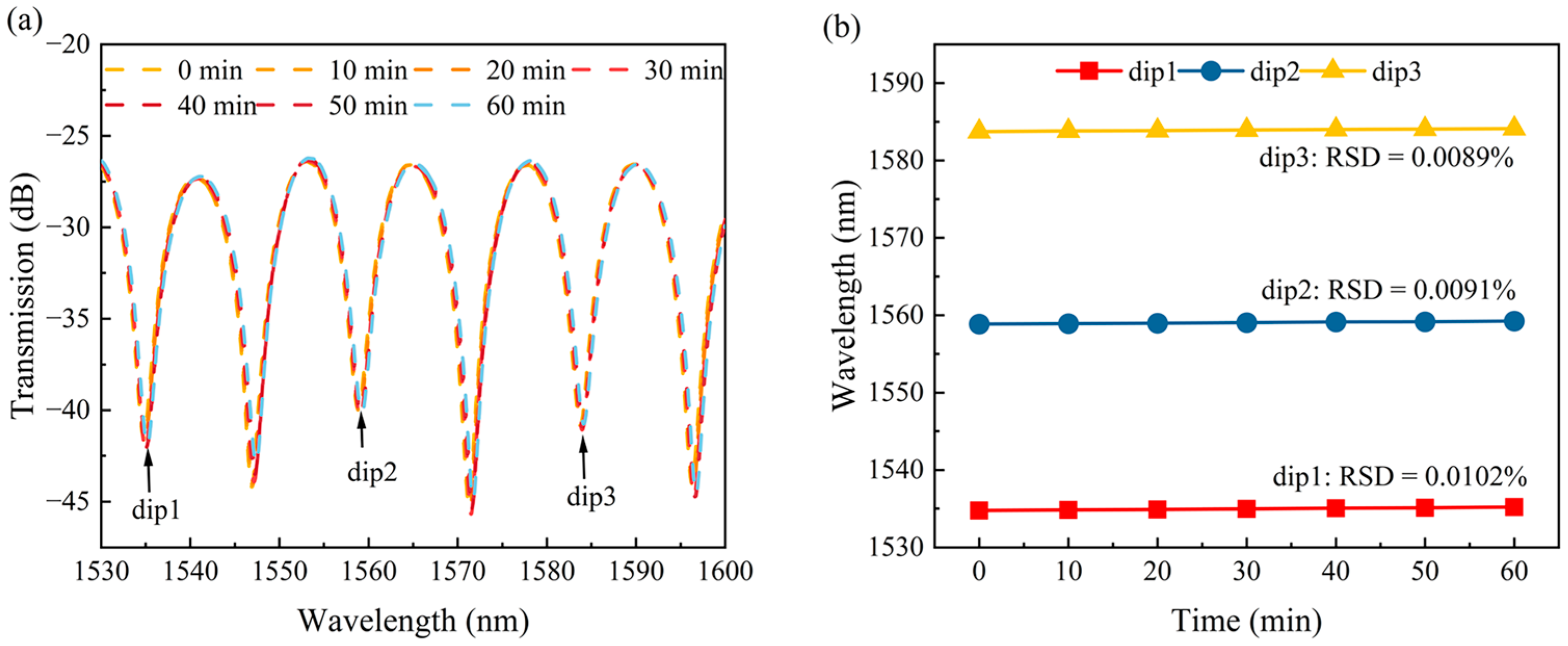
| Application | Sensor | Advantageous Interferometer Type | Measurement Range | Sensitivity | Ref. |
|---|---|---|---|---|---|
| RI sensor | Tapered seven-core fiber | MZI | 1.3330–1.3451 | 1435.76 nm/RIU | [27] |
| Salinity sensor | SMF-MMF-etched DSHF-MMF-SMF | MZI | 0–40‰ (1.3313–1.3395) | −2 nm/‰ (−10,872 nm/RIU) | [28] |
| Salinity sensor | SMF-OFFSET-SMF-SMF | MZI | 20–40‰ | −2.4473 nm/‰ (~−15,000 nm/RIU) | [29] |
| RI sensor | Microfiber-Assisted U-Shape Cavity | MZI | 1.3197–1.3250, 1.3434–1.3475 | −8449 nm/RIU, −13,245 nm/RIU | [30] |
| RI sensor | SMF-OFFSET-SMF-SMF | MZI | 1.3328–1.3398 | 13,936 nm/RIU | [31] |
| RI sensor | Superimposed coated LPG-FBG | LPFG-FBG | 1.3300–1.3420 | 2326.7 nm/RIU | [32] |
| RI sensor | PCF-MMI | MMI-PCF | 1.3330–1.3775 | 342.78 nm/RIU | [33] |
| RI sensor | SM-OSNS | MZI | 1.3370–1.3410 | −13,703 nm/RIU | This paper |
Disclaimer/Publisher’s Note: The statements, opinions and data contained in all publications are solely those of the individual author(s) and contributor(s) and not of MDPI and/or the editor(s). MDPI and/or the editor(s) disclaim responsibility for any injury to people or property resulting from any ideas, methods, instructions or products referred to in the content. |
© 2024 by the authors. Licensee MDPI, Basel, Switzerland. This article is an open access article distributed under the terms and conditions of the Creative Commons Attribution (CC BY) license (https://creativecommons.org/licenses/by/4.0/).
Share and Cite
Zhou, J.; Sun, Y.; Liu, H.; Li, H.; Wang, Y.; Jiang, J.; Xu, D.; Yao, J. The Highly Sensitive Refractive Index Sensing of Seawater Based on a Large Lateral Offset Mach–Zehnder Interferometer. Sensors 2024, 24, 3887. https://doi.org/10.3390/s24123887
Zhou J, Sun Y, Liu H, Li H, Wang Y, Jiang J, Xu D, Yao J. The Highly Sensitive Refractive Index Sensing of Seawater Based on a Large Lateral Offset Mach–Zehnder Interferometer. Sensors. 2024; 24(12):3887. https://doi.org/10.3390/s24123887
Chicago/Turabian StyleZhou, Jingwen, Yue Sun, Haodong Liu, Haibin Li, Yuye Wang, Junfeng Jiang, Degang Xu, and Jianquan Yao. 2024. "The Highly Sensitive Refractive Index Sensing of Seawater Based on a Large Lateral Offset Mach–Zehnder Interferometer" Sensors 24, no. 12: 3887. https://doi.org/10.3390/s24123887






